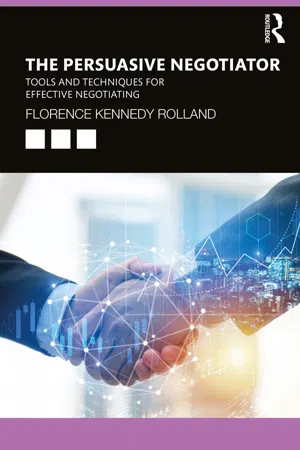
The Persuasive Negotiator
Tools and Techniques for Effective Negotiating
- 232 pages
- English
- ePUB (mobile friendly)
- Available on iOS & Android
About this book
Negotiation permeates every aspect of our lives, from our home to our work. Whether you consider yourself a novice or expert, there is always room to improve your negotiation performance. With easily replicable tools throughout, this book offers everything you need to know for an MBA in negotiation, but without the expense and time-consuming study. It will help you improve both your confidence and ability, and equip you with all the skills and tools needed for successful negotiation.
Negotiation is more than buying and selling, more than winning and more than streetwise manipulation; it's creating a successful deal that will lead to a fruitful relationship with the other party. In this book, the author demonstrates how we can all become more effective negotiators in business, and our everyday lives, by combining theory with real-life examples and offering practical tips. At the end of each chapter, your knowledge will be tested and the learning reaffirmed to enable you to walk into any negotiation confidently.
This book is essential reading to all students taking part in an MBA program, as well as anyone with an interest in negotiation. Whether you need help negotiating a new kitchen installation, a better salary or a multi-million-pound business deal, this book will give you the competitive edge to get there.
Frequently asked questions
- Essential is ideal for learners and professionals who enjoy exploring a wide range of subjects. Access the Essential Library with 800,000+ trusted titles and best-sellers across business, personal growth, and the humanities. Includes unlimited reading time and Standard Read Aloud voice.
- Complete: Perfect for advanced learners and researchers needing full, unrestricted access. Unlock 1.4M+ books across hundreds of subjects, including academic and specialized titles. The Complete Plan also includes advanced features like Premium Read Aloud and Research Assistant.
Please note we cannot support devices running on iOS 13 and Android 7 or earlier. Learn more about using the app.
Information
1What is negotiation?
Introduction
Alternative methods of making decisions
Say ‘No’
Persuasion
I tried to be reasonable and explained why Dan should choose somebody else, but he was not interested in my views, only in his own, which shows I was right to call him an idiot of a boss, and he proved this by sacking me.
Problem-solve
Chance
Negotiate
Arbitrate
Table of contents
- Cover
- Half Title
- Title Page
- Copyright Page
- Dedication
- Table of Contents
- List of Figures
- List of Tables
- 1 What is negotiation?
- 2 Distributive bargaining
- 3 Integrative bargaining, part 1: Preparation
- 4 Integrative bargaining, part 2: Debate
- 5 Integrative bargaining, part 3: How to propose
- 6 Integrative bargaining, part 4: How to bargain
- 7 : The styles of negotiation
- 8 Rational bargaining
- 9 Ploys and tactics
- 10 Culture and negotiation